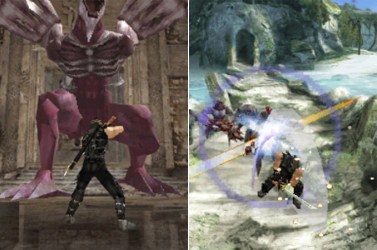Console Yourself:
Ninja Gaiden Dragon Sword
“The enemy takes many forms.” - Instruction Manual
Format: Nindendo DS • Developer: Team Ninja • Released: Apr 2008
Having used a second volleyball game to temporarily satiate their disturbing fascination with soft core pornography, this year has thankfully seen Team Ninja focussing on a more entertaining aspect of the sprawling Dead Or Alive franchise. The main event was the release of the long-awaited Ninja Gaiden II, with this handheld incarnation of the action game serving as a warm up. Thankfully, Tecmo’s decision not to outsource production of the DS title has been handsomely rewarded. The title’s goal in respect of the larger cannon is a curious one- to undo all the narrative consequences of its acclaimed predecessor. In the 2004 title, Ryu Hayabusa waged a (nearly) one-man war on the evil Vigorian Empire, and the supernatural creatures that ruled it. He was remarkably successful in this goal, killing the Fiend Emperor and destroying the mcguffin “Dark Dragon Blade”, an ancient artefact that the game’s plot revolved around. Dragon Sword progressively undoes most of these events, making clear the mechanics of the Fiends’ resurrection in readiness for the forthcoming big-budget sequel.
In structure, the game is a perfect facsimile of its big brother. Split into a number of chapters, it takes place in a fully exploreable world, it is, in which Ryu must fight enemies & bosses, unlock new areas and advance the plot through cut scenes. The majority of the action has polygonal characters moving in 3D against a static backdrop. The resultant difficulty of depth-perfection means that combat is a simplified form of that in the last instalment, though the onslaught from all sides quickly gives the game its own feel, as frenetic reactions are required to face the crowds. The boss battles occur in true 3D arenas, with the freely moving camera enabling a reasonable reproduction of the original title’s tactics and strategy. Like the DS’s Zelda title, Dragon Sword sees its protagonist being almost entirely controlled through the touch screen, with the console being held like a book and block assigned to the buttons and d-pad. Considered in the abstract, it’s an absurd system, effectively mapping move, jump, attack, projectiles, evade and ninpo to the same button. Occasionally, this approach to controlling Ryu trips itself up, and you die because the input method can’t keep up with your actions. Far more remarkable, however, are the many times when the player forgets that they are using a handheld, and the game includes all the action of its Xbox predecessor.
 |
There’s been some thought given to the differing audience which the handheld title will have to cater for. In contrast to the tale of despair and hatred previously documented, Dragon Sword has a much warmer tone, with frequent interludes featuring the Hayabusa village, its children in particular. Where Ryu once pursued a bloodthirsty vendetta, here he fights to save his childhood sweetheart’s little sister. This different feel is due in part to the change in art direction, with Team Ninja’s psuedo-CG style discarded in place of a more manga-influenced approach. Ninja Gaiden became infamous for the difficulty spike that arose after ten minutes of action, with many players simply giving up on finding themselves unable to defeat Murai. There’s a nice in-joke here as the first boss is able to easily overwhelm the player, only for the story to proceed while taking account of this. (There’s a nice little bonus waiting for players with the patience to actually overcome this initial challenge.) In the main, however, there’s little that will pose too much of a challenge here, with the difficulty broadly level throughout.
The title’s one real weakness stems from it being development simultaneously with its more lavish Xbox 360 counterpart. One of the defining features of Ninja Gaiden was the sheer variety of influences, with each level introducing radically different settings and enemies, imbuing the player with real curiosity about what lay around the next corner. In this respect, it harked back to the 16-bit generation, when a radically different location could be conjured by simply changing a background image, instead of weeks of 3D modelling. With Team Ninja’s concept artists being fully occupied on the true sequel, Dragon Sword has had to make do with leftovers, with all but one of the game’s locations being taken directly from the first game. The plot accommodates this well, with one of Hayabusa’s initial motivations being to find out how he can be in a building that he previously destroyed. However, vague interest in what area will be revisited next is no substitute for the exploration of the original game, a fact further underlined by the recycling of music and bosses from that title. Production values are high, with the original cast retained for limited voice-acting duties, and a wide range of art assets used to bring the plot to life in cut scenes. The game is commendably well stocked with extras, with many optional challenges, several difficulty settings available on completion and hidden artefacts that unlock story-related trivia scattered throughout the levels.
Bringing a series famed for its niche appeal to a console built around accessibility is an undeniably odd choice, but it’s hard to imagine the task being performed better than in this example. Despite being sometimes completely faithful to the original, it nonetheless manages to establish itself as a fully-fledged entry in its parent series.
![]()
About this entry
- By Julian Hazeldine
- Posted on Saturday, August 23 2008 @ 1:50 am
- Categorised in Games, Review
- Tagged with Ninja Gaiden, Team Ninja, Temco, Console Yourself
- 0 comments
